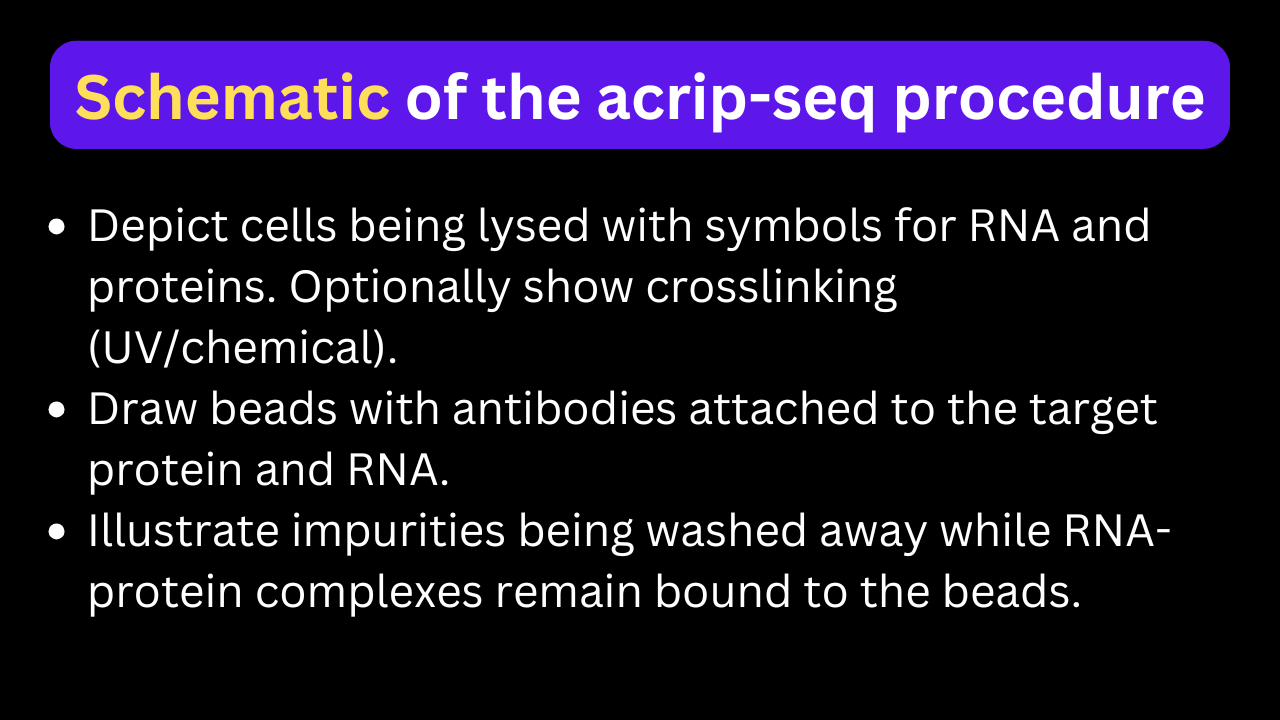ACRIP-Seq (Antibody-Coupled RNA Immunoprecipitation followed by Sequencing) is a technique used to analyze RNA-protein interactions.
Here is a step-by-step Schematic of the acrip-seq procedure.
Steps in ACRIP-Seq procedure
- Cell Lysis and RNA-Protein Crosslinking
- Cells are lysed under conditions that preserve RNA-protein complexes.
- Crosslinking (optional, using UV light or chemical agents) stabilizes RNA-protein interactions.
- Immunoprecipitation
- An antibody specific to the target protein is used to capture RNA-protein complexes.
- The antibody-protein-RNA complex is immobilized on beads (e.g., magnetic or agarose beads coated with Protein A/G).
- Washing
- Unbound RNA, proteins, and other contaminants are washed away to purify the RNA-protein complexes.
- RNA Recovery
- RNA is released from the immunoprecipitated complexes, usually by protein digestion or heat treatment.
- Crosslinks are reversed if applied.
- RNA Purification
- Extracted RNA is purified using standard methods (e.g., phenol-chloroform extraction, column-based purification).
- Library Preparation
- RNA is converted to complementary DNA (cDNA) via reverse transcription.
- cDNA is amplified, adapter-ligated, and indexed for sequencing.
- High-Throughput Sequencing
- Prepared libraries are subjected to next-generation sequencing (NGS).
- Data Analysis
- Sequencing reads are aligned to the genome/transcriptome to identify RNA molecules interacting with the protein of interest.
- Enrichment analysis and bioinformatics tools are used to infer RNA-protein interaction sites and functional relevance.
Illustration Elements for the Schematic
- Step 1 (Cell Lysis): Depict cells being lysed with symbols for RNA and proteins. Optionally show crosslinking (UV/chemical).
- Step 2 (Immunoprecipitation): Draw beads with antibodies attached to the target protein and RNA.
- Step 3 (Washing): Illustrate impurities being washed away while RNA-protein complexes remain bound to the beads.
- Step 4 (RNA Recovery): Show RNA strands being separated from proteins.
- Step 5 (RNA Purification): Depict a clean RNA strand post-purification.
- Step 6 (Library Preparation): Include an image of RNA being reverse transcribed and prepared for sequencing.
- Step 7 (Sequencing): Display a sequencer with cDNA strands being read.
- Step 8 (Data Analysis): Add a graphical representation of bioinformatics analysis, such as aligned reads mapped to a genome.
